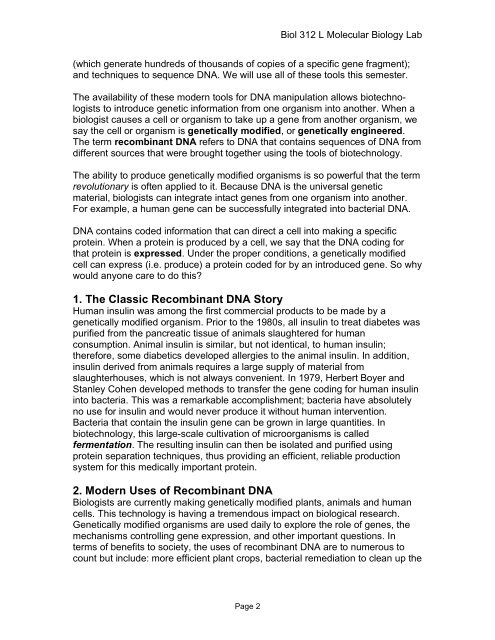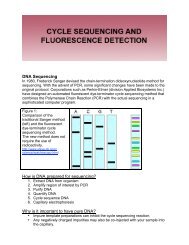DNA Cloning
DNA Cloning
DNA Cloning
Create successful ePaper yourself
Turn your PDF publications into a flip-book with our unique Google optimized e-Paper software.
Page 2<br />
Biol 312 L Molecular Biology Lab<br />
(which generate hundreds of thousands of copies of a specific gene fragment);<br />
and techniques to sequence <strong>DNA</strong>. We will use all of these tools this semester.<br />
The availability of these modern tools for <strong>DNA</strong> manipulation allows biotechnologists<br />
to introduce genetic information from one organism into another. When a<br />
biologist causes a cell or organism to take up a gene from another organism, we<br />
say the cell or organism is genetically modified, or genetically engineered.<br />
The term recombinant <strong>DNA</strong> refers to <strong>DNA</strong> that contains sequences of <strong>DNA</strong> from<br />
different sources that were brought together using the tools of biotechnology.<br />
The ability to produce genetically modified organisms is so powerful that the term<br />
revolutionary is often applied to it. Because <strong>DNA</strong> is the universal genetic<br />
material, biologists can integrate intact genes from one organism into another.<br />
For example, a human gene can be successfully integrated into bacterial <strong>DNA</strong>.<br />
<strong>DNA</strong> contains coded information that can direct a cell into making a specific<br />
protein. When a protein is produced by a cell, we say that the <strong>DNA</strong> coding for<br />
that protein is expressed. Under the proper conditions, a genetically modified<br />
cell can express (i.e. produce) a protein coded for by an introduced gene. So why<br />
would anyone care to do this?<br />
1. The Classic Recombinant <strong>DNA</strong> Story<br />
Human insulin was among the first commercial products to be made by a<br />
genetically modified organism. Prior to the 1980s, all insulin to treat diabetes was<br />
purified from the pancreatic tissue of animals slaughtered for human<br />
consumption. Animal insulin is similar, but not identical, to human insulin;<br />
therefore, some diabetics developed allergies to the animal insulin. In addition,<br />
insulin derived from animals requires a large supply of material from<br />
slaughterhouses, which is not always convenient. In 1979, Herbert Boyer and<br />
Stanley Cohen developed methods to transfer the gene coding for human insulin<br />
into bacteria. This was a remarkable accomplishment; bacteria have absolutely<br />
no use for insulin and would never produce it without human intervention.<br />
Bacteria that contain the insulin gene can be grown in large quantities. In<br />
biotechnology, this large-scale cultivation of microorganisms is called<br />
fermentation. The resulting insulin can then be isolated and purified using<br />
protein separation techniques, thus providing an efficient, reliable production<br />
system for this medically important protein.<br />
2. Modern Uses of Recombinant <strong>DNA</strong><br />
Biologists are currently making genetically modified plants, animals and human<br />
cells. This technology is having a tremendous impact on biological research.<br />
Genetically modified organisms are used daily to explore the role of genes, the<br />
mechanisms controlling gene expression, and other important questions. In<br />
terms of benefits to society, the uses of recombinant <strong>DNA</strong> are to numerous to<br />
count but include: more efficient plant crops, bacterial remediation to clean up the



